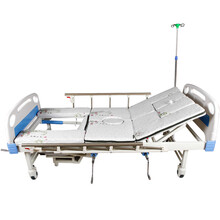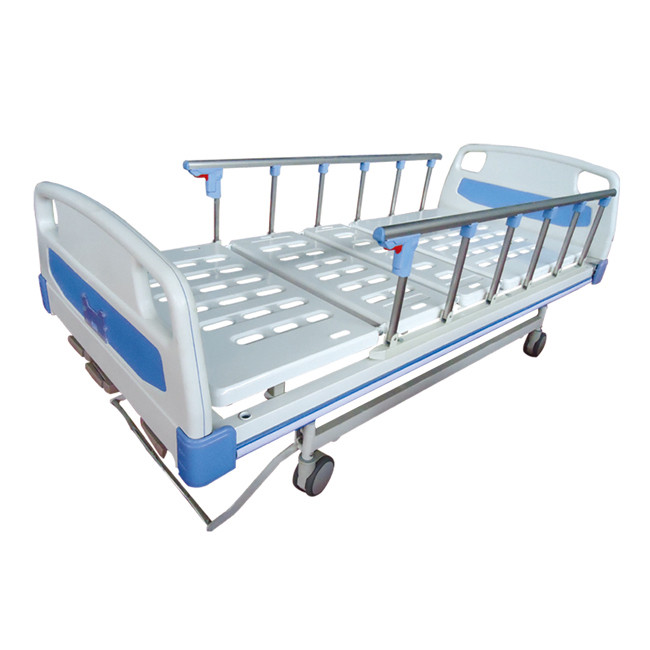1、 Lock in core functions according to “nursing needs”: reject “functional stacking” and focus on practical and essential needs
1. Mild disability/autonomous activity
Core requirement: Self adjustment of body position to reduce dependence on others.
◦ Essential features: Electric back lift (adjustable from 0 ° -70 °)+Electric leg lift (0 ° -40 °) (convenient for getting up, eating, and moving the lower limbs), paired with a large button remote control (clear font, with night light, and can be operated by the elderly with one hand).
◦ Optional assistance: electrically adjustable bed height (50-70cm adjustable, suitable for wheelchairs or convenient for getting in and out of bed), single-sided folding guardrail (anti fall when getting up, flexible to retract during care).
2. Severe disability/long-term bedridden patients
Core requirements: prevention of pressure ulcers, convenient care, and reduction of physical injuries.
◦ Essential features: electric flip (30 ° -45 ° timed flip left and right)+electric toilet hole (silent opening and closing, with a cover curtain) (to avoid skin friction caused by frequent handling and protect privacy), equipped with full bed lifting (with a displacement machine for barrier free transfer, with a load capacity of ≥ 200kg).
· Key details: sectional breathable board (ABS material or perforated steel plate) is selected for the bed surface, and the standard anti pressure sore mattress (inflatable or gel type, to disperse body pressure) is configured.
2、 Putting ‘safety’ first: 3 details to eliminate hidden dangers
1. Guardrail design: adjustable+fully enclosed
◦ It is necessary to choose a height ≥ 30cm, double-sided foldable guardrail (to prevent tipping over when standing up, and to fold one side close to the elderly during care to avoid fixed guardrail collision), with rounded edges and no burrs (to prevent scratching).
2. Braking and stability: “Mobile fixed” dual insurance
The bed legs are equipped with 4 independent locking brakes (flexible when moving and not moving when fixed), and the bed frame is made of thickened steel or aluminum alloy (structurally stable and not shaking, especially for those with heavy weight, attention should be paid to the load-bearing parameters).
3. Emergency power supply: Do not “cut off protection” when power is cut off
◦ Priority should be given to styles with spare batteries (which can be adjusted 1-2 times during power outages to avoid elderly people being trapped in uncomfortable positions), with a power cord length of ≥ 2 meters (away from dragging risks, suitable for most room socket positions).
3、 Adapting to “family scenarios”: balancing space, operation, and cleanliness
1. Size measurement: Don’t let the bed “crush” the room
Standard bed size: 190-210cm in length (suitable for adults), 80-100cm in width (80-90cm for small-sized apartments, leaving enough nursing space on both sides of ≥ 50cm); If you need to move or store, you can choose to fold the headboard/detachable footboard (easier to move in stairwells).
2. Simplified operation: Caregivers can get started in 10 minutes
Remote control design: Clear function key zoning (independent large buttons are set for common functions such as lifting/turning over/lowering the bed, and combination buttons are set for secondary functions such as toilet holes), better support for voice broadcasting (voice prompts when pressing buttons to reduce misoperation).
Motor noise:<50dB during operation (equivalent to normal speaking sound, to avoid waking up the elderly during nighttime adjustment, can be listened to on-site when purchasing).
3. Clean and friendly: reduce the “extra burden” of care
◦ The bed board is detachable (convenient for wiping dust in the gaps), the edge of the toilet hole area is smooth (do not scratch when cleaning), and the bed bottom is at least 15cm above the ground (the sweeping robot can enter, reducing hygiene blind spots).
4、 Material and comfort: ‘Detail’ determines long-term experience
1. Bed surface and mattress: breathable+support dual online
Bed board: Made of ABS material (lightweight, easy to clean, moisture resistant) or thickened cold-rolled steel plate (strong load-bearing), both need to have breathable holes (to avoid sweating on the back); The preferred mattress is an independent spring+breathable latex layer (supporting the waist and reducing turning noise), or a medical pressure ulcer resistant inflatable mattress (suitable for long-term bed rest).
2. Edge treatment: rounded and free of edges and corners
The headboard and tailboard of the bed are designed with circular arcs (to avoid collisions), and the gap at the folding of the guardrail is ≤ 5cm (to prevent hand clamping). The details and craftsmanship reflect the brand’s texture.
Ultimately, a suitable electric nursing bed should allow users to “lie down comfortably and move easily”, allowing caregivers to “operate with ease and care with peace of mind” – focusing on needs, paying attention to details, and identifying after-sales service, in order to choose a truly “usable and long-lasting” good bed.
Post time: Jun-11-2025



